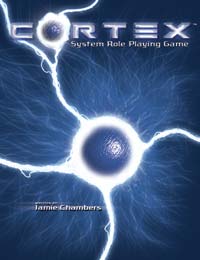Review: Cortex System Role Playing Game from Margaret Weis Productions
Margaret Weis Productions steps into the generic role-playing rules arena with the release of the “Cortex” rules system by Jamie Chambers. The system is already

in use in some other games, notably MWP’s “Battlestar Galactica” offering. I just finished the book and this my review.
Full Disclosure: I received a free copy of this book from the publisher for this review.
I feel I must mention one thing before diving into the book itself. MWP included a code for a PDF version of the book from RPGnow.com inside “Cortex.” This is an excellent idea and frankly needs to be an industry standard. I understand there are issues with intellectual property rights, distribution channels and piracy, but relying solely on dead-tree books is a recipe for obsolescence. If nothing else, it is a great “thank you” to those that actually pay for books rather than downloading pirated scans. Well done, MWP!
Stepping off of my soapbox, I now descend into the nuts and bolts of “Cortex.” The book is 158 pages long in a perfect bound format.
“Cortex” starts off by describing what it is not. This is a “fuzzy” rules system, more interested a fun gaming experience than carefully balanced, mathematically precise rules. Cortex focuses on being easy to learn and running quickly on the game table. It is not for the math geek/rules lawyers of the gaming world.
Game mechanics are quite simple. Each statistic or skill has a die assigned. A d2 rating is below human average and d12 is superhuman. Skills work the same way. You combine a statistic (agility) with a skill (gymnastics) to generate a pool of dice and then use those dice to reach a target number. Missing the number means failure while wildly exceeding the target number grants success and perhaps a GM assigned benefit for your Gymkata skills.
One aspect of the system I found interesting was the skills are not mapped to specific attributes. If you judged a gymnastics competition in game, then a combination of intelligence and gymnastics is perfectly acceptable. It adds a nice layer of flexibility into the mechanics.
Character generation is a standard point buy setup, with the ability to buy “traits.” Traits are either assets or complications. Assets provide some benefit to the character, such as fast healing or a photographic memory and cost character generation points. Complications add more points to your character creation pool, but add some defects to the PC, ie alcoholism, phobias, etc.
One other rules item concerns “plot points.” These points allow the PCs to increase dice pools, pretty standard in many games, but they also allow the PCs to change the environment during play. During a game, a PC needs to slow down an oncoming horde of zombies and only has a pistol. One burned plot point later and now a propane gas cylinder appears in the scene. One good shot and the zombies spend two rounds burning. I thought this had some abuse potential, but as long as the GM has a good group of players, it could be a lot of fun.
I am glossing over much of the rules detail. Cortex has a strong basic rules set that covers many game situations (magic, psionics, implants, drugs) and provides clear examples of using the rules. I read through the book initially on the plane back from GTS and felt I could run a game after about two hours of reading.
Cortex is a “generic” RPG rules set, so it does not have a “base” campaign world, a la “Greyhawk” for old “Dungeons and Dragons.” There are some campaign world examples in the book, each one is 3-5 pages of story background, NPCs. They are a CSI flavored police procedural called “Trace,” “Arcady,” based on books by Michael Williams and have a fantasy/horror flavor. “Star of the Guardians” by Margaret Weis is a space opera involving genetically superior people with energy swords fighting over the lost scion of a fallen noble house. There is a chapter with some NPC/monster examples, but there are only 10 pages of critters and they cover such a broad range that they are more examples for creating your own NPCs rather than a “codex of monsters.”
I know that Cortex advertises itself as a “tool kit approach” to gaming, but some more campaign information and NPCs would have been nice. This is my only concern about “Cortex,” that it is so “do-it-yourself” that beginning gamers may be intimidated. A rookie GM should look towards the existing games (ie Serenity or BSG) that use the system, rather than trying to create something from scratch. If you are an experienced gamer or think you have the energy to create a world from scratch, then this is the book for you.
Normally I talk about art in game books, but there is very limited art in “Cortex.” It is of reasonable quality, but there is so little it clearly was not a priority for this book. Cortex is all business.
I have rambled on too long. Other than my “no rookie GM” reservation, I really enjoyed “Cortex” and thought it had some nice mechanics and a clean set of rules. I look forward to seeing some more supplements using this rules set.
Trask, The Last Tyromancer
Pingback:Supernatural Role Playing Game | Jamie Chambers
Pingback:The Alliterates » Supernatural Role Playing Game